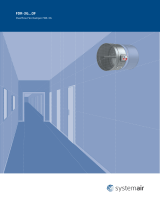Page is loading ...

Sound Transmission
Application Note
Rev. 1.4 | 14-07-2021
Amina Technologies Limited
Cirrus House, Glebe Road, Huntingdon, Cambridgeshire, PE29 7DL, England
T: +44 (0) 1480 354390 | E: [email protected] | W: www.aminasound.com
Introduction
Sound transmission is the spread of sounds through materials and air. It is an important
area of consideration when planning any loudspeaker system, and where possible
should be planned for at the design stage, before any construction takes place.
In any typical home or commercial space, relatively loud sources of sound are usually audible in other
areas of the building, most prominently in spaces with shared boundaries. When planning an audio
system, thought must be given to its intended use and if sound transmission is likely to be an unwanted
byproduct. For example, in a ground floor home cinema (where relatively high volume levels are
desirable) directly beneath a child’s bedroom (where silence is desirable in the evenings and at night)
its use would be compromised where there is poor sound isolation between the two spaces. Multi-
room audio systems are another case where results can fall short of expectation without taking the
appropriate steps to isolate the different zones. This could result in unrelated sources in different zones
bleeding into each other. There are 4 main targets when addressing unwanted sound transmission:
More mass between spaces will reduce sound
transmission in the vast ma jority of cases. Us-
ing multiple layers of plasterboard is a common
approach to building up mass, and using layers
with differing densities / stiffnesses / thicknesses
will provide better isolation because each material
will affect different areas of the sound spectrum.
For example, using a sheet of high density plaster-
board with a sub-sheet of plywood is a good idea,
or a top sheet of high density board and a bottom
sheet of 15mm standard board. Acoustic under-
lay (adding mass AND damping) can also be very
effective in reducing sound trasmission between
floors.
1: Increase surface mass
By introducing compliance (or ‘springiness’) into a
structure, some of the impact of sound waves on its
surfaces will be absorbed before entering the wall
or ceiling framing, and transmission is thus reduced.
An effective step is to use an acoustic barrier mat
(such as Acoustiblok) between the stud frame and the
plasterboard substrate. This is a rubber membrane
that will add damping as well as partly decoupling the
board from the frame. Alternatively, where a multi-
ple-skin wall has been used, Green Glue can be used
to provide panel damping between the layers. This is
incredibly efficient at damping panel vibration and
reducing mechanical sound transmission.
Another option is to use a resilient clip and hat chan-
nel for plasterboard installation. This uses rubber iso-
lation mounts within the clips to isolate the hat chan-
nel and plasterboard from the stud frame. This kind of
system can be used on both sides of the treated wall.
2: Add damping

Sound Transmission
Application Note
Rev. 1.4 | 14-07-2021
Sound Transmission
Application Note
Rev. 1.4 | 14-07-2021
Amina Technologies Limited
Cirrus House, Glebe Road, Huntingdon, Cambridgeshire, PE29 7DL, England
T: +44 (0) 1480 354390 | E: [email protected] | W: www.aminasound.com
3: Isolate / decouple
This method physically decouples the two sides of
the wall, greatly reducing the vibrational energy
transferred from one side to the other. The easiest
construction method here is a staggered stud wall.
This is a common construction method where each
stud is only attached to one side of the wall, with
studs on alternating sides, reducing the direct
transmission path across the structure. To go a
step further, rather than staggering the studs,
separate stud frames can be constructed for either
side of the wall. This will increase cavity depth, but
is even more effective at hindering transmission
since the direct mechanical transmission path is
further reduced.
4: Block air paths.
Mechanical transmission and airbourne transmission
work together as sound propagates thoughout a
structure. Sealing up air pathways between spaces
where isolation is desired a very simple step to take.
Specialist acoustic rated caulking is available for this
purpose; usually a paintable acrylic based material
which has intumescent qualities for fire protection.
This means they can be used extensively for fire
proofing and sound-proofing internal frames and
sealing joints. Noise flanking paths for airborne noise
such as passive ventilation ducts that may connect
adjacent rooms may be less obvious but are equally
important.
In-wall / in-ceiling speakers
When compared to traditional in-room loudspeakers, all in-wall / in-ceiling speakers will exhibit differ-
ent transmission properties due to the fact they are directly coupled to the finished surface and can
be exposed to the cavity space, but with proper preparation this should not be an issue. Amina recom-
mends and supplies sealed back-boxes which typically reduce rearward sound projection by 26dB in the
mid-frequencies, as well as creating a tuned acoustic cavity for the loudspeaker panel. Cavity spaces
should be air-sealed and filled with high-mass insulation (for example Rockwool RW45A).
Plasterboard back-boxes, when used in conjunction with Amina’s range of CV backboxes have proved to
be very effective in further reducing sound transmission between rooms for high SPL applications. Plas-
terboard backboxes can be constructed quickly and easily using materials that are typically to hand on
site. (Detailed plans are outlined on the next page.)
In all cases there are always many solutions to reduce sound transmission problems, and the above is
only intended as a guide to the most common and efficient methods of isolation. For specific guidance
around sound transmission, an acoustic specialist should be consulted.

Sound Transmission
Application Note
Rev. 1.4 | 14-07-2021
/
